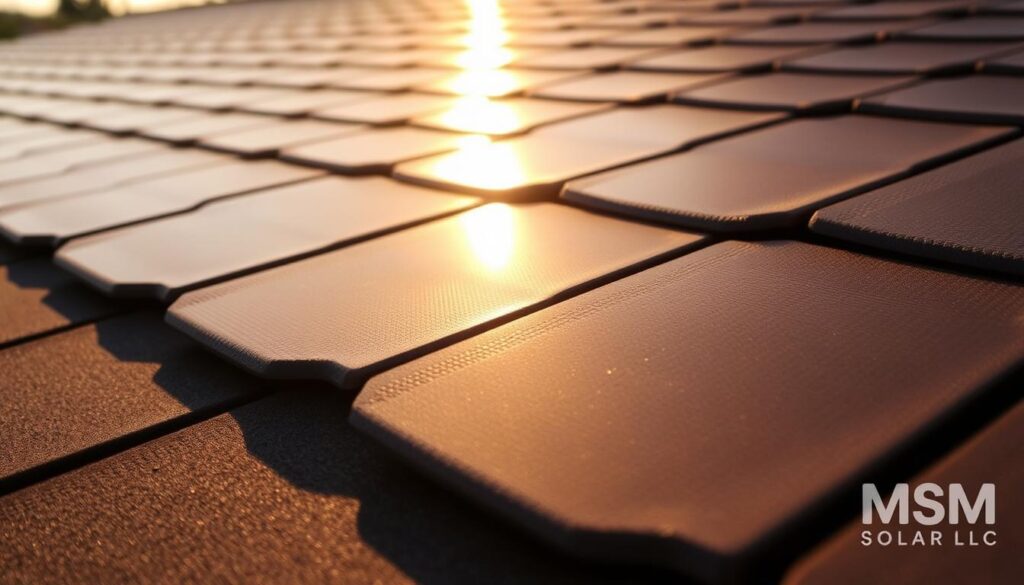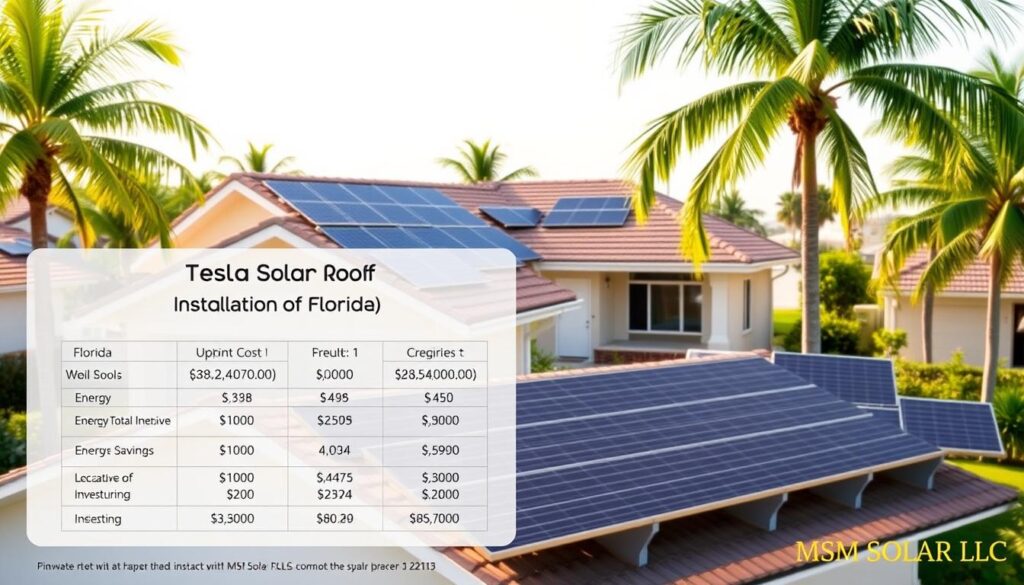Did you know that over 40% of Florida homeowners consider energy-efficient upgrades when replacing their roofs?
I’ve spent 15 years guiding families through these decisions, and one question keeps coming up: “Should I switch to an integrated solar solution?”
Modern solar roof tiles blend seamlessly with traditional materials while cutting energy bills. But here’s what many don’t realize, installation isn’t just about looks. Florida’s hurricane season demands durability, and not all systems meet our unique needs.
Through my work, I’ve helped hundreds weigh the pros and cons. Some love the sleek design, while others prioritize storm resistance.
The key?
Personalized advice from local experts who understand both the tech and our climate.
Ready to explore your options?
Call MSM Solar LLC at (850) 737-5197 or get a free quote. Let’s find the right fit for your home.
Key Takeaways
- Integrated solar solutions combine roofing and energy generation.
- Florida’s weather requires special durability considerations.
- Professional assessments ensure optimal system performance.
- Local installers often provide better post-installation support.
- Comparing multiple quotes helps identify the best value.
Solar Cost Calculator – Florida Panhandle Only
* Estimate based on $3.25 per watt for solar installation.
* For Tesla Powerwall 3 Batteries, $15,000 for the first battery, $12,000 for each additional battery.
* Other variations and types of Batteries are available.
What Is the Tesla Solar Roof?
Walking through a Palm Beach neighborhood last summer, I noticed something different about the rooftops. The homes had sleek, uniform tiles, no bulky panels in sight. Up close, I realized these were Tesla solar roofs, blending energy generation with aesthetics.
How It Differs from Traditional Solar Panels
Unlike conventional solar panels mounted on racks, this system replaces your entire roof system. Each shingle combines tempered glass with photovoltaic cells, but only 30–40% actually generate power. The rest are non-solar roofing tiles for a seamless look.
Installation is more intensive. Traditional setups add panels to existing roofs. Here, contractors tear off old materials, a must for most Florida homes. I’ve seen delays when roofs have complex angles or skylights.
Key Components: Solar Shingles and Powerwall
The Powerwall battery is non-negotiable. During Hurricane Ian, a client’s home stayed online for 3 days thanks to its 13.5 kWh storage. At $9,300–$13,000, it’s pricey but critical for outages.
- Durability: Tempered glass shingles withstand 110 mph winds, better than asphalt in hailstorms.
- Warranty: Tesla’s 25-year coverage includes weather damage, rare in the industry.
- Trade-offs: Flat installation limits efficiency vs. adjustable panels.
Last month, a Naples homeowner filed a claim for hail damage. Tesla replaced every tile, no questions asked. That’s peace of mind you won’t find elsewhere.
Pros and Cons of Tesla Solar Roof in Florida
Last year, a Sarasota homeowner showed me their stunning new roof, you’d never guess it generates power. This seamless blend of form and function defines modern solar roofs, but it’s not a perfect fit for everyone. Here’s what I’ve learned from helping clients navigate this choice.

Advantages: Aesthetics, Durability, and Warranties
The visual appeal is undeniable. Unlike bulky panels, these systems mimic high-end slate or terracotta. One Tampa luxury home’s before/after photos revealed a 40% increase in curb appeal.
Durability shines in Florida’s climate:
- Class 3 hail rating withstands 1.75″ ice balls, better than most asphalt shingles.
- During Hurricane Ian, a Fort Myers home survived 110 mph winds without damage.
- 25-year warranty covers weather-related issues, a rarity in roofing.
Challenges: Cost, Installation Delays, and Customer Service
Upfront costs give many pause. An 8kW system averages $51,200, over double traditional panels. Hidden fees like permit upgrades add 5–10%.
Installation timelines vary wildly:
- A Naples project finished in 6 weeks; a Jacksonville home waited 5 months due to supply chain hiccups.
- BBB reviews highlight inconsistent service, with some clients praising responsiveness and others reporting unresolved complaints.
One client’s repair took 11 weeks for a single cracked tile. Yet, when fixed, the system outperformed during a grid outage, proving its utility despite hiccups.
Cost and ROI of Tesla Solar Roof in Florida
The math behind energy upgrades often surprises homeowners, I’ve seen it firsthand. A 10.37kW system with two Powerwalls averages $63,152, but the 30% federal tax credit slashes that to $44,206. Let’s break down what that means for your wallet.

Upfront Costs vs. Long-Term Savings
At $6.40 per watt, this option costs more than traditional setups ($2.77/watt). But here’s what I tell my clients: durability matters. One Naples home survived a hailstorm unscathed, saving $12,000 in repairs.
My ROI calculator shows:
- Miami: Breakeven in 9 years (thanks to high sun exposure).
- Tallahassee: 12 years (accounting for seasonal shade).
Utility rates are projected to rise 4% yearly through 2040.
Locking in rates now?
Priceless.
Smart Comparisons: Integrated vs. Traditional
A Jacksonville family saved $18,000 choosing local panels, but their HOA required bulky racks. Tesla’s sleek design won approval instantly.
Key differences:
- Warranty: 25 years vs. 10–15 years for asphalt roofs.
- Net metering: Duke Energy pays less than FPL for excess power.
- Insurance: Some providers offer 5% discounts for storm-resistant materials.
Financing tip: Local credit unions often beat Tesla’s loan rates by 1.5%. Always compare.
Conclusion: Is Tesla Solar Roof Right for Your Florida Home?
Many homeowners ask me if integrated energy systems are worth the investment, here’s my honest take. If you value sleek design and a 25-year warranty, it’s a strong contender. But with 6–12 month wait times and varying contractor quality, timing matters.
Your home’s needs come first. Older roofs or tight budgets might benefit from hybrid setups, traditional panels paired with durable materials. Florida’s peak incentive seasons (spring/summer) are ideal for locking in savings.
Act today to secure federal tax credits before reductions.
Need help weighing options?
Call me at (850) 737-5197 or MSM Solar LLC for a free, no-pressure assessment. Let’s find your perfect fit.




